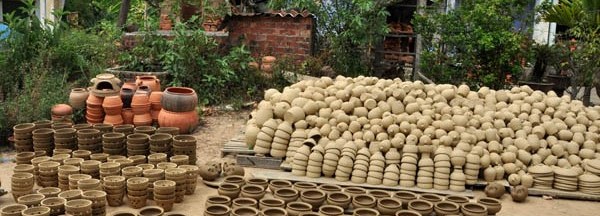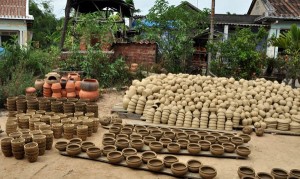Between the 15th -16th centuries, Northern immigrants introduced handicrafts to the Southern part of Vietnam, including Quang Nam. This led to the development of the place which carried on even after more than hundreds of years later. Today, the “Occupation Village” preserved not only a centuries-old tradition but even made itself known to the rest of the world with its signature crafts and products. Thus, Hoi An has earned recognition for the following industry for a particular area: Kim Bong for its carpentry; Thanh Ha for its pottery; Phuoc Kieu for bronze casting; Ma Chau for silk weaving; and others.
Thanh Ha Pottery Village. Clay is the primary raw material used for molding home products like bowls, jars, vases, and ornamental tree pots, just to name a few. Each item is unique with its own color and shape but all of high quality. Tourists who visit the place not only get to buy souvenirs but actually see how the pottery process is done. Thanh Ha Pottery Village is located at Cam Ha Commune, Hoi An City.
Kim Bong Carpentry Village. Situated at Cam Kim Commune, Hoi An City, Kim Bong Carpentry Village is said to have been established in North Vietnam, specializing in wood carving and sculpture. Along with their own ideas, Kim Bong carpenters also took inspiration from artisans in Japan, China, and Chiem Thanh, among others. Kim Bong products are known to be artistically beautiful and philosophically meaningful. Also of the best kind, the items are sold not only domestically but in the foreign market as well.
Tra Que Vegetable Village. Famous for producing vegetables like lettuce, basil, coriander, houttuynia and flagrant knoutwed, just to name some and used in Quang Nam’s specialties like soft noodle soup and dry pancake roll with pork, among many others. Composed of about ten hectares of cultivated land, vegetable planting has become the main occupation of the local residents for many generations past. The industry is doing so well that it is now supplying to establishments such as restaurants and wholesale markets not only in Quang Nam but also in Da Nang City. The business brings in an annual income of about VND billions. As part of its tourism efforts, visitors are taught how to plant vegetables and even cook the local specialties.
Phuoc Kieu Bronze Casting Village. The village makes exceptional products like bells, gongs, gong-like musical instruments incense burners, lamp holders, ancient vases, and other bronze musical instruments used in local festivals, ceremonies and even in daily life. Each musical instrument is made with a mixture of different kinds of metals, producing a one-of-a-kind sound for each.
Ma Chau Weaving Village. In the past, only aristocrats, mandarin classes and other prestigious people used to be able to afford and allowed to use woven silk. Almost everyone at Ma Chau was involved in the weaving industry, going through the process of growing silkworms, opening silkworm cocoons and finally weaving them. When the government of South Vietnam allowed world trade in the 19th century, Ma Chau silk was the most exported product. Through time, silk weaving in Ma Chau adapted with modernization and technology and advanced from the traditional wooden looms to half-machine and eventually to full automation.
Dong Yen – Thi Lai Mulberry Silkworm Village. While Ma Chau Village is famous for weaving silk, Dong Yen – Thi Lai Village is where the process begins, from growing the silkworms, unraveling cocoons and finally weaving. The village used to grow more than 160 hectares of mulberries so it came naturally that almost everyone knew the process and involved in the business itself. Products created from the mulberry silkworm include satin, tussore, chiffon and mattresses which were exported to the Eastern region. Today, cities such as Bay Hien and Go Vap in Ho Chi Minh City participate in a large scale mulberry silkworm industry.
Ban Thach Mat Village. Made from jute found along the banks of Thu Bon River, Ban Thach women create simple but beautiful mats that are exported domestically. The village has also become a popular tourist destination because of its extraordinary products.
Cotu Ethnic Brocade Weaving. Not an official occupation village, but one which definitely preserves and promotes a part of Vietnamese culture. Usually performed by women as well who make elegant items like blankets, loincloths and skirts from materials found domestically like cotton and flax aside from the standard jute. The looms are traditional, made from either bamboo or wood. All products are hand-made and of the best kind, requiring a lot of effort and time from days to even a month. Visitors will be taught how to weave basic brocade products as part of their tour.

